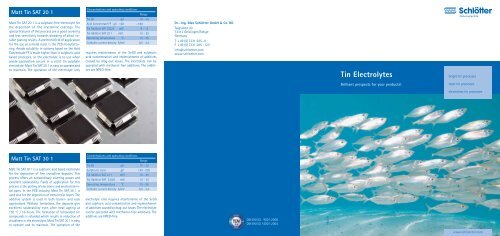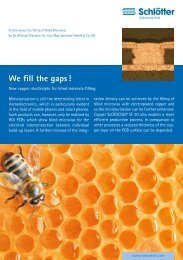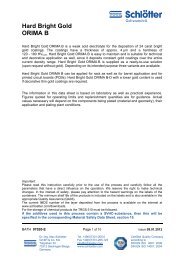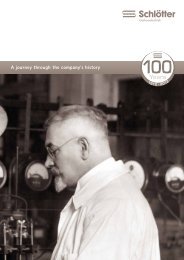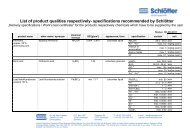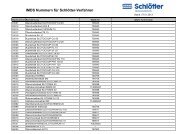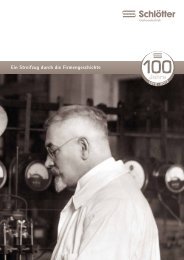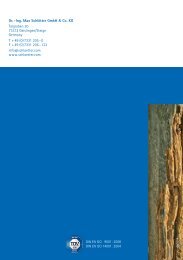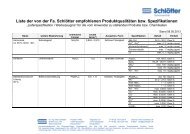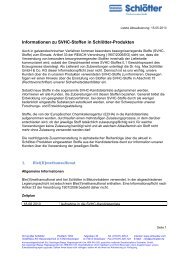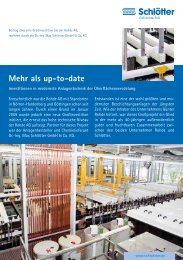Tin Electrolytes - Schloetter.de
Tin Electrolytes - Schloetter.de
Tin Electrolytes - Schloetter.de
- No tags were found...
Create successful ePaper yourself
Turn your PDF publications into a flip-book with our unique Google optimized e-Paper software.
Matt <strong>Tin</strong> SAT 20 1Concentrations and operating conditionsRangeMatt <strong>Tin</strong> SAT 20 1 is a sulphate-free electrolyte forthe <strong>de</strong>position of fine crystalline coatings. Thespecial features of this process are a good coveringand less sensitivity towards bleeding of alkali solubleplating resists. A preferred field of applicationfor the use as a metal resist is the PCB manufacturing.Ano<strong>de</strong> solubility in systems based on the AcidConcentrate FF is much higher than in sulphuric acidbased processes, so the electrolyte is to use whenano<strong>de</strong> passivation occurs in a matt tin sulphateelectrolyte. Matt <strong>Tin</strong> SAT 20 1 is easy to operate andto maintain. The operation of the electrolyte only<strong>Tin</strong> (II) g/l 10 - 30Acid Concentrate FF g/l 120 - 180<strong>Tin</strong> Additive SAT 22/26 ml/l 8 - 12<strong>Tin</strong> Additive SAT 23 1 ml/l 15 - 25Operating temperature °C 15 - 30Cathodic current <strong>de</strong>nsity A/dm 2 0,5 - 2,0requires maintenance of the Sn(II) and sulphuricacid concentration and replenishment of additivescaused by drag-out losses. The electrolyte can beoperated with methanol free additives. The additivesare NPEO-free.Dr. - Ing. Max Schlötter GmbH & Co. KGTalgraben 3073312 Geislingen/SteigeGermanyT + 49 (0) 7331 205 - 0F + 49 (0) 7331 205 - 123info@schloetter.comwww.schloetter.com<strong>Tin</strong> <strong>Electrolytes</strong>bright tin processesBrilliant prospects for your products!matt tin processeselectroless tin processesMatt <strong>Tin</strong> SAT 30 1Concentrations and operating conditionsRangeMatt <strong>Tin</strong> SAT 30 1 is a sulphuric acid based electrolytefor the <strong>de</strong>position of fine crystalline <strong>de</strong>posits. Thisprocess offers an extraordinary covering power an<strong>de</strong>xcellent sol<strong>de</strong>rability. Fields of application for thisprocess is the plating of electronic and electrotechnicalparts. In the PCB industry, Matt <strong>Tin</strong> SAT 30 1 isused also for the <strong>de</strong>position of metal resist layers. Theadditive system is used in both barrel- and rackapplications. Without limitations, the <strong>de</strong>posits giveexcellent sol<strong>de</strong>rability even after heat ageing at155 °C / 16 hours. The formation of tetravalent tincompounds is retar<strong>de</strong>d which results in reduction ofcloudiness in the electrolyte. Matt <strong>Tin</strong> SAT 30 1 is easyto operate and to maintain. The operation of the<strong>Tin</strong> (II) g/l 10 - 30Sulphuric acid g/l 140 - 200<strong>Tin</strong> Additive SAT 31 1 ml/l 10 - 25<strong>Tin</strong> Additive SAT 32/26 ml/l 10 - 25Operating temperature °C 15 - 30Cathodic current <strong>de</strong>nsity A/dm 2 0,5 - 2,0electrolyte only requires maintenance of the Sn(II)and sulphuric acid concentration and replenishmentof additives caused by drag-out losses. The electrolytecan be operated with methanol-free additives. Theadditives are NPEO-free.DIN EN ISO 9001:2008DIN EN ISO 14001:200406/2014www.schloetter.com
Bright <strong>Tin</strong> SLOTOTIN 70Bright <strong>Tin</strong> SLOTOTIN 70 is a sulphuric acid base<strong>de</strong>lectrolyte for the <strong>de</strong>position of very bright tin layers.Even in very low current <strong>de</strong>nsities e.g. parts with acomplex surface geometry light zinc layers are still<strong>de</strong>posited. The sol<strong>de</strong>rability of the tin coatings <strong>de</strong>positedfrom Bright <strong>Tin</strong> SLOTOTIN 70 is excellent andremains excellent even after heat ageing tests(e.g. 155 °C / 16 hours). The usual cloud formation ofa sulphuric acid based tin electrolyte by tetravalenttin compounds is retar<strong>de</strong>d in Bright <strong>Tin</strong> SLOTOTIN 70.A troublesome foaming does therefore not occurwhen operating this electrolyte. This is especiallybeneficial for barrel application since stronglyfoaming wetting agents would have a strong foamingeffect during the barrel lift-out. The additives requiredfor electrolyte make-up and operation meet therequirements of the RoHS Directive (Restriction ofcertain Hazardous Substances) EU Directive 2011/65/EU. The additives are free of alkylphenylethoxylaterespectively nonlyphenylethoxylate (NPEO).Bright <strong>Tin</strong> GF 20 1Bright <strong>Tin</strong> GF 20 1 is an organic acid-based fluori<strong>de</strong>andformal<strong>de</strong>hy<strong>de</strong>-free process for the <strong>de</strong>position ofbright tin coatings. Sol<strong>de</strong>rability of the tin coatings isexcellent, even after accelerated heat ageing at e.g.155 °C for about 16 hours and the <strong>de</strong>posits aren’tsensitive towards fingerprints. Bright <strong>Tin</strong> GF 20 1 canbe used for the <strong>de</strong>position of bright tin coatings inrack installations and at <strong>de</strong>greased metal content forbulk articles in barrel plants in the field of electronican<strong>de</strong>lectrotechnical component production includingthe printed circuit board (PCB) manufacturing.Bright <strong>Tin</strong> GF 20 1 is especially recommen<strong>de</strong>d for theapplication on small electronic components (ceramicchips) which tend to stick together. An especially<strong>de</strong>veloped additive prevents the parts as far as possiblefrom sticking together. The additives are NPEO-free.Glass, ceramic or titanium aren’t being attacked sinceConcentrations and operating conditionsRack Barrel<strong>Tin</strong> (II) g/l 15 - 25 10 - 20Sulphuric acid g/l 160 - 200 60 - 200Starter SLOTOTIN 71 ml/l 15 - 25 15 - 25Operating temperature °C 10 - 30 10 - 30Cathodic current <strong>de</strong>nsity A/dm 2 1,0 - 2,5 ≥ 0,4Concentrations and operating conditionsRack / BarrelRange<strong>Tin</strong> (II) g/l 8 - 25Acid Concentrate FF g/l 150 - 250Starter GF 21 1 ml/l 10 - 40Operating temperature °C 15 - 25Cathodic current <strong>de</strong>nsity A/dm 2 > 0,6 - 3,0the electrolyte doesn’t contain any fluori<strong>de</strong>. The useof titanium ano<strong>de</strong> hooks is possible for the contactingof ano<strong>de</strong>s if drag-in of fluori<strong>de</strong> ions or complex fluori<strong>de</strong>ions is prevented. If required the Bright <strong>Tin</strong> GF 20 1can be operated as a tin-lead electrolyte by addingLead Concentrate FP. This process is applied ifsulphuric acid based electrolytes cannot be used, e.g.if a crossing of tin-lead electrolytes is unavoidabledue to plant-specific reasons.<strong>Tin</strong> SLOTOTIN MT 1110The <strong>Tin</strong> SLOTOTIN 1110 is a strongly acidic, fluori<strong>de</strong>-freeprocess for the <strong>de</strong>position of matt to silky-matt, finecrystalline coatings. This process is applied in barrelplants for the coating of chips and small electronic components.Components plated with <strong>Tin</strong> SLOTOTIN 1110show clearly less ten<strong>de</strong>ncy to stick together like it’sknown from previously common processes. The <strong>de</strong>positsfrom <strong>Tin</strong> SLOTOTIN 1110 give excellent sol<strong>de</strong>rability andmelting behaviour in reflow processes even after heatageing (155 °C / 16 hours). The coatings contain a smallamount of bismuth.<strong>Tin</strong> SLOTOTIN MT 1080 is a sulphuric acid-base<strong>de</strong>lectrolyte for the <strong>de</strong>position of silky-matt tincoatings. For acidic matt tin electrolytes an unusuallygood covering power combined with an excellentsol<strong>de</strong>rability are the specific features of this process.The applications relate to tin plating of electronic orelectrotechnical components. Additive SLOTOTINMT 1081 is used in the same composition for barrelandrack parts. The sol<strong>de</strong>rability of the <strong>de</strong>positsremains unlimited excellent even after a heat ageingtest of 16 h / 155 °C. Cloud formation caused by theformation of Sn(IV) is retar<strong>de</strong>d.Concentrations and operating conditionsRange<strong>Tin</strong> (II) g/l 10 - 30Acid Concentrate FF g/l 200 - 300Additive SLOTOTIN MT 1111 ml/l 30 - 60Additive SLOTOTIN MT 1112 ml/l 0,25 - 2,0Operating temperature °C 20 - 40Cathodic current <strong>de</strong>nsity A/dm 2 > 0,1 - 2,0Concentrations and operating conditions<strong>Tin</strong> SLOTOTIN MT 1080Range<strong>Tin</strong> MBF 20<strong>Tin</strong> MBF 20 is a strongly acidic, fluori<strong>de</strong>-free processfor the <strong>de</strong>position of silky-matt fine crystallinecoatings. It is used for tin plating of wires and tapesin reel-to-reel plating lines. The additives used arelow foaming and so during operation no disturbingfoam formation occurs. The <strong>de</strong>posits from <strong>Tin</strong>MBF 20 give excellent sol<strong>de</strong>rability and meltingbehaviour in reflow processes even after heatageing (e.g. 155 °C / 16 hours).<strong>Tin</strong> (II) g/l 15 - 30Sulphuric acid g/l 150 - 200Additive SLOTOTIN MT 1081 ml/l 10 - 30Operating temperature °C 15 - 30Cathodic current <strong>de</strong>nsity A/dm 2 > 0,5 - 2,0Concentrations and operating conditionsRange<strong>Tin</strong> (II) g/l 30 - 120 AcidAcid Concentrate FF g/l 70 - 135Additive SLOTOTIN MBF 16 1 ml/l 10 - 30Operating temperature °C 35 - 60Cathodic current <strong>de</strong>nsity A/dm 2 10 - 80Matt <strong>Tin</strong> SLOTOTIN 40The Matt <strong>Tin</strong> SLOTOTIN 40 is a strongly acidic, fluori<strong>de</strong>-freeprocess for the <strong>de</strong>position of silky-matt finecrystalline coatings. This process is mainly applied inreel-to-reel plants. With reduced tin concentration itcan also be used for rack- and barrel applications.<strong>Tin</strong> is <strong>de</strong>posited in a grain size of 3 - 8 μm and tendsto less formation of whiskers in comparison to brighttin layers (grain size < 1 μm). The <strong>de</strong>posited tin layerscontain only low quantities of co-<strong>de</strong>posited organiccompounds. Measured as carbon, the values areapprox. 0.005 % by weight. The additives don’t<strong>de</strong>compose during <strong>de</strong>position. Therefore, the carbonco-<strong>de</strong>position rate remains low even after longeroperating period. Sol<strong>de</strong>rability of the tin coatingsBright <strong>Tin</strong> GBF 30Bright <strong>Tin</strong> GBF 30 is for the use in high speedreel-to-reel installations. The fluori<strong>de</strong>-free acidicelectrolyte <strong>de</strong>posits bright tin coatings. Dependingon plant conditions and operating temperaturecathodic current <strong>de</strong>nsities up to 30 A/dm² can beachieved. Sol<strong>de</strong>rability is still excellent even aftertempering (aging test). The additives used arelow foaming. This results, even during intensiveelectrolyte agitation to no foam formation.Immersion <strong>Tin</strong> SN 30 1Immersion <strong>Tin</strong> SN 30 1 is a process for the electroless<strong>de</strong>position of tin on copper and copper alloysvia charge exchange. Deposition is also possible onlead surfaces. Therefore, this process can also beused to brighten lead- or tin-lead coatings. Smoothbright tin layers approx. 1 - 2 μm thick are <strong>de</strong>positedon copper surfaces at a temperature of 70 °C,still enabling sol<strong>de</strong>rability after tempering (e.g. 4hours at 155 °C). Immersion <strong>Tin</strong> SN 30 1 can beregenerated. The copper which accumulates overtime can be separated from the electrolyte. Componentsrequired for <strong>de</strong>position may be replenishedaccording to analysis. As usual with conventionalimmersion tin electrolytes, disposal of the tinConcentrations and operating conditionsRange<strong>Tin</strong> (II) g/l 30 - 120Acid Concentrate FF g/l 70 - 200Additive SLOTOTIN MBF 41 1 ml/l 30 - 70Operating temperature °C 35 - 60Cathodic current <strong>de</strong>nsity A/dm 2 10 - 80<strong>de</strong>posited from Matt <strong>Tin</strong> SLOTOTIN 40 is still excellentafter heat ageing at (155 °C / 16 hours) and can befused. The process has been <strong>de</strong>veloped as a lead-freealternative for all types of components. The coating iscompatible with all lead-free tin-based sol<strong>de</strong>r-alloys.Concentrations and operating conditionsRange<strong>Tin</strong> (II) g/l 30 - 120Make-up Concentrate GBF 33 g/l 100 - 200Additive SLOTOTIN MBF 16 1 ml/l 10 - 30Operating temperature °C 35 - 60Cathodic current <strong>de</strong>nsity A/dm 2 10 - 80Concentrations and operating conditionsRange<strong>Tin</strong> (II) g/l 15 - 25Make-up Concentrate SN 31 ml/l 100 - 120Activation Salt SN 33 g/l 80 - 120Additive CULMO AN 11 1 ml/l 5 - 15Operating temperature °C 20 - 80Exposition time: <strong>de</strong>pends on the required thicknessof layer, max. up to approx. 2 µm are possible.plating solution is not required. The layers <strong>de</strong>positedfrom this electrolyte meet the requirements of theRoHS Directive (Restriction of certain HazardousSubstances) EU Directive 2011/65/EU. The additivesare NPEO-free.


